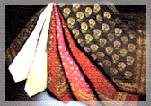This is the second dance performed by four members of MCTLA during Malaysia's merdeka celebration on Sept 6 at the Wilshire Plaza Hotel in Los Angeles. The other dance
D`Artz : dance
Monday, May 28, 2007
Tarian Songket II
Posted by
putriza
at
9:02 PM
0
comments
![]()
Labels: dance, Los Angeles., songket, special
Tarian Songket..
At LA Convention Center on the 18th June 2006. This is their Tarian Songket. Songket is a piece of clothing that Malays wear during special occasions such as
D`Art : tarian
Posted by
putriza
at
8:55 PM
0
comments
![]()
Friday, May 4, 2007
So Beautiful.....
 Woven on a Malay frame loom, elaborate patterns are created by introducing extra gold or silver weft threads with the use of a flat needle or cuban.
Woven on a Malay frame loom, elaborate patterns are created by introducing extra gold or silver weft threads with the use of a flat needle or cuban.
The songket goes through eight stages before it becomes a piece of fabric and it is still traditionally woven. As weavers are usually from rural areas, it is not surprising to find that the motifs are patterned after local flora and fauna. These motifs are also named after local Malay delicacies such as seri kaya, wajik, and the tepung talam, believed to be favourites of royalty. Exclusive songket requires between one and three months to complete, while ordinary songket only takes about 3 days.
Exclusive songket requires between one and three months to complete, while ordinary songket only takes about 3 days.
Men wore the songket fashioned into a destar or head-cloth. It was only later that Malay women started wearing songket sarung or sarung worn in 'rolling waves; style with a baju kurung top. Today songket is a popular choice for the Malay wedding costume and is often presented by the groom to the bride as one of the wedding gifts. In order to preserve the original lustre and quality of the songket, a large cowry shell known as genus is normally used to polish the cotton fabric or songket cloth before the telepuk process is initiated. Telepuk is another beautiful handicraft creation of the Malay society in the olden days. Composed of golden lace, this fabric is used specially for official functions.
Telepuk is another beautiful handicraft creation of the Malay society in the olden days. Composed of golden lace, this fabric is used specially for official functions.
D`Artz : Songket in Malaysia
The Wonderful Of Songket...
 Songket is fabric which belongs to the brocade family of textiles. It is hand woven in silk or cotton, and intricately patterned with gold or silver threads. The metallic threads stand out on the background cloth to create a shimmering effect. In the weaving process the metallic threads are inserted in between the silk or cotton weft (latitudinal) threads of the main background cloth. The term 'songket' comes from the Malay word menyongket, ‘to embroider with gold or silver threads’. Songket is traditionally worn during ceremonial occasions.
Songket is fabric which belongs to the brocade family of textiles. It is hand woven in silk or cotton, and intricately patterned with gold or silver threads. The metallic threads stand out on the background cloth to create a shimmering effect. In the weaving process the metallic threads are inserted in between the silk or cotton weft (latitudinal) threads of the main background cloth. The term 'songket' comes from the Malay word menyongket, ‘to embroider with gold or silver threads’. Songket is traditionally worn during ceremonial occasions.
In Indonesia, Songket is produced in Sumatra, Kalimantan, Bali, Sulawesi, Lombok and Sumbawa. Outside of Indonesia production areas include the east coast of the Malay Peninsula and Brunei.
Songket weaving is historically associated with areas of Malay settlement, and the production techniques could have been introduced by Arab and Indian merchants. Historically, production was located in politically significant kingdoms because of the high cost of materials; the gold thread used was originally made of real gold.
D`Artz : Songket












